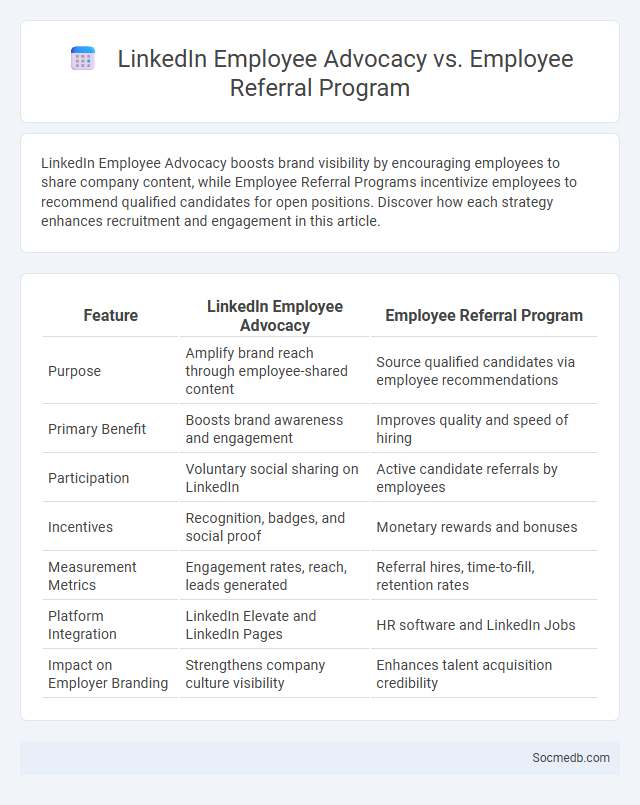
Photo illustration: LinkedIn Employee Advocacy vs Employee Referral Program
LinkedIn Employee Advocacy boosts brand visibility by encouraging employees to share company content, while Employee Referral Programs incentivize employees to recommend qualified candidates for open positions. Discover how each strategy enhances recruitment and engagement in this article.
Table of Comparison
| Feature | LinkedIn Employee Advocacy | Employee Referral Program |
|---|---|---|
| Purpose | Amplify brand reach through employee-shared content | Source qualified candidates via employee recommendations |
| Primary Benefit | Boosts brand awareness and engagement | Improves quality and speed of hiring |
| Participation | Voluntary social sharing on LinkedIn | Active candidate referrals by employees |
| Incentives | Recognition, badges, and social proof | Monetary rewards and bonuses |
| Measurement Metrics | Engagement rates, reach, leads generated | Referral hires, time-to-fill, retention rates |
| Platform Integration | LinkedIn Elevate and LinkedIn Pages | HR software and LinkedIn Jobs |
| Impact on Employer Branding | Strengthens company culture visibility | Enhances talent acquisition credibility |
Understanding LinkedIn Employee Advocacy
Understanding LinkedIn employee advocacy can significantly enhance Your brand visibility and credibility by leveraging authentic employee voices to share company content. Employee advocacy on LinkedIn increases reach, drives engagement, and fosters trust among professional audiences, making it a powerful tool for business growth. Companies that empower employees to engage on LinkedIn see higher referral rates and stronger professional networks.
What is an Employee Referral Program?
An Employee Referral Program is a structured system used by companies to encourage current employees to recommend qualified candidates from their network for open job positions. This program leverages your social connections, offering incentives or rewards when referred candidates are successfully hired, boosting recruitment efficiency. Incorporating this strategy into social media platforms enhances visibility and engagement, tapping into wider talent pools.
Defining Employee Advocacy: Beyond LinkedIn
Employee advocacy extends beyond LinkedIn by empowering staff to share authentic company content across multiple social media platforms, enhancing brand visibility and trust. This strategy leverages employees' personal networks on platforms like Twitter, Facebook, and Instagram to amplify marketing efforts and foster genuine engagement. Tools for employee advocacy facilitate content sharing, track performance, and ensure consistent messaging, driving organic growth and improving recruitment outcomes.
Key Differences: LinkedIn Employee Advocacy vs Employee Referral Program
LinkedIn Employee Advocacy leverages employees' personal networks to share branded content, enhancing company visibility and thought leadership through authentic engagement. In contrast, an Employee Referral Program incentivizes employees to recommend qualified candidates for open positions, accelerating recruitment and improving candidate quality. While advocacy boosts brand awareness and trust, referral programs primarily drive talent acquisition and hiring efficiency.
Goals and Objectives: Advocacy vs Referral Initiatives
Social media strategies differ significantly when focusing on advocacy versus referral initiatives, with advocacy aiming to build brand loyalty and empower customers to promote your message authentically. Referral initiatives target measurable growth by incentivizing users to share products or services within their networks, driving direct traffic and conversions. Your social media goals should align with either fostering long-term engagement through advocacy or generating immediate results through referral campaigns.
Platform and Tools Comparison
Leading social media platforms such as Facebook, Instagram, Twitter, LinkedIn, and TikTok offer distinct features tailored to diverse user demographics and content strategies. Facebook excels in community building with comprehensive group and event tools, while Instagram prioritizes visual content through Stories and Reels, enhancing engagement for brands targeting younger audiences. Twitter provides real-time updates and trending topics analysis, LinkedIn supports professional networking and B2B marketing with advanced job posting and analytics tools, and TikTok's algorithm-driven content discovery fosters viral trends via short-form videos.
Impact on Employer Branding and Company Culture
Social media profoundly shapes employer branding by showcasing authentic company values and employee experiences, influencing talent attraction and retention. It serves as a platform for transparent communication, fostering a positive company culture that emphasizes collaboration and inclusivity. Employee engagement and public perception on platforms like LinkedIn and Glassdoor directly impact organizational reputation and competitiveness in the job market.
Measuring Success: Metrics for Each Strategy
Engagement rate, click-through rate, and follower growth are essential metrics for evaluating social media success. Monitoring reach and impressions helps assess content visibility across platforms like Instagram, Facebook, and Twitter. Conversion rate and return on investment (ROI) provide insights into the effectiveness of social media campaigns in driving business goals.
Pros and Cons: Choosing the Right Approach
Social media offers unparalleled opportunities for personal branding, business growth, and real-time communication, allowing you to reach a global audience instantly. However, it also presents challenges such as privacy concerns, misinformation spread, and time management issues that can impact mental health and productivity. Carefully balancing content sharing, privacy settings, and engagement strategies will help you maximize benefits while minimizing risks.
Integrating Employee Advocacy and Referral Programs for Maximum ROI
Integrating employee advocacy and referral programs amplifies your brand's reach by leveraging authentic voices within your workforce, driving higher engagement and trust on social media platforms. This synergy boosts recruitment efficiency and enhances content distribution, generating a significantly higher ROI compared to traditional marketing methods. Focusing on empowering employees to share tailored content and refer top talent creates a scalable strategy that maximizes impact and cost-effectiveness for your business.
 socmedb.com
socmedb.com